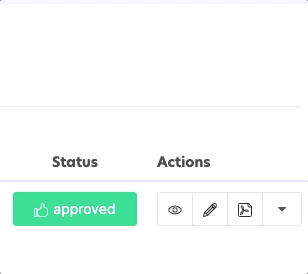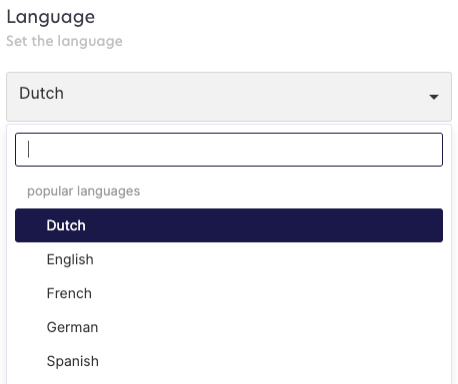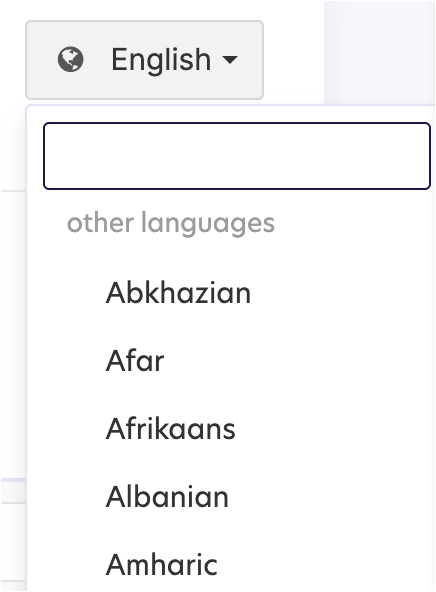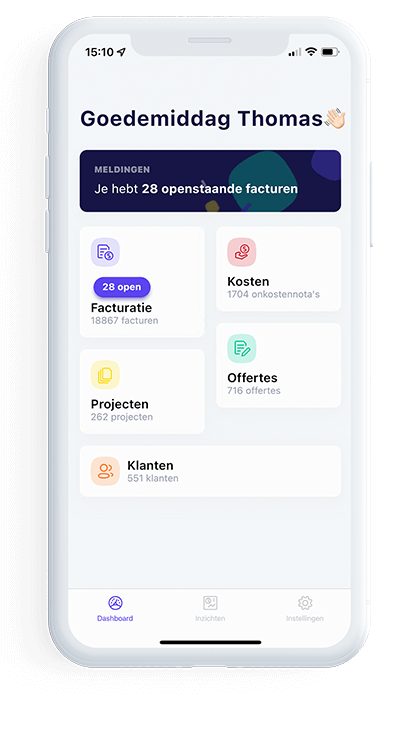
Sending invoices in 134 languages: from Abkhazian to Zulu
You can use two methods to create an invoice in another language. Translate it in a text document or use an invoicing tool that has built-in translations. The latter saves you time and prevents you from making mistakes. Which method do you prefer?
Table of contents
Why would you even send an invoice in a foreign language?
Important note before sending invoices in another language
What needs to be translated on an invoice?
How to create an invoice in any language?
Useful FAQ about invoicing in other languages
- Can you change translations of invoices
- Which invoice program supports RTL?
- If you invoice in a foreign language, do you need to use another currency too?
- Which invoice program allows the non Latin alphabet?
Why would you even send an invoice in a foreign language?
Sending an invoice in the language of your customer is a clear sign of customer centricity. International customers can certainly appreciate the effort you do when communicating in their language. Especially when it comes to money.
Besides the appreciation, there is another big win for you.
When you send an invoice in your customer’s language, you will avoid questions and delayed payments. When those happen, you can better use a proper email to remind your customer about the overdue payment.
This not only applies to corporate customers with strict procedures to approve and process invoices.
A small business, for instance, can hire an accountant who is not fluent in other languages.
In the end, this person needs to process your invoice. When it is composed in another language, that can cause a bottleneck in the administration.
Invoicing in the language of your customers can lead to faster payments.
Important note before sending invoices in another language
Before creating and sending an invoice in another language, investigate whether this will get you in trouble with
Your local legislation
Your accountancy (program or office)
Tax administration
If this is not the case, go ahead. Create the invoice and send it.
In the other case, you can always consider creating a separate translation of the invoice.
But please be aware that every invoice has a unique ID.
Regardless of the format you use, there is always a sequential number involved:
Year - Date - Invoice Number (e.g.: 2022-12-12-00000678)
Or Prefix - Invoice Number (e.g.: INV-000678)
If you were to copy these invoices in an invoicing program and then translate them, the numbers would go up.
2022-12-12-00000678: your English invoice
2022-12-12-00000679: your Spanish invoice for the same services and customer
For the tax administration, these are two different invoices.
Both are added to your revenue. And you will be taxed for both (VAT, taxes on profit, etc.).
You don’t want that to happen, do you?
A better way is to translate the original invoice into, e.g., a Word document and send it as an attachment along with your original invoice.
Make sure
you mention TRANSLATION on the translated invoice
and use the same invoice number as the original in your translation
Avoid sending your customers two invoices for the same order
What parts of an invoice do you need to translate?
An invoice is an official document. You cannot afford to translate it partially. Luckily, invoices have a limited set of elements that need to be included. Think of the word “invoice” itself, the “expiration date”, etc.
We have listed these elements in this article, along with an example of an English invoice.
All these words need to be translated. For example:
Date (English ) = Datum (German, Dutch)
Invoice (English) = Factuur (Dutch) = Faktur (German)
Luckily, translating this is a one time only task.
The harder part may be the descriptions of your services or products.
These need to be accurately translated because some countries charge extra, or no taxes for certain services or goods. If they get lost in translation, that can hurt your business.
Quotations are a good test of the quality of your translations. This is how it works:
Translate your quotations. Many organisations and even consumers will demand you do this before doing business with you. If something is not clear or wrong, they will let you know.
If your customer doesn’t make any remarks, you can turn the offer into an invoice with one click.

Mistakes in translated invoices could cost you money further down the administrative road.
How to create an invoice in any language?
Depending on the software you use to create your invoices, the translation can be daunting or a breeze.
In CoManage, for instance, you only need to select one of the 5 built-in translations to switch default phrases into another language.
English
Spanish
French
German
Dutch

Besides these languages, you can choose from 129 others. Alphabetically, the list goes from Abkhazian to Zulu. Further down, you can see if your language is included too.
For the non-default languages, you only need to do a minor effort.
In the invoice configuration settings, you can select any of the languages.

Then, you fill in the translation next to the original element.

Save your settings and you can create your invoice in the language of your choice.
Useful FAQ about invoicing in other languages
Can you change translations of invoices?
Before you submit your invoice to the tax administration, you can change your translated invoices. However, it is highly recommended that your customer receives exactly the same final invoice.
The reason for this is that countries exchange tax information. When it turns out that the invoice you sent doesn’t match the one you sent to your customer, you may get into trouble.
Which invoice program supports RTL?
If you want to create an invoice in RTL (right to left), you can best use CoManage. The program is suitable for the following RTL languages:
Arabic
Persian
Hebrew
Kurdish
Urdu
If you invoice in a foreign language, do you need to use another currency too?
Invoicing customers in another currency than yours is also a sign of customer friendliness. In that respect, translating an invoice may often not be enough for businesses with serious international ambitions.
We have published a dedicated article about this, packed with tips and advice. But in brief: if one day you need to include a foreign currency on your invoice, your life would be so much easier if you use CoManage.
Which invoice program allows the non-Latin alphabet?
Sending an invoice in another language often implies that you need to use another script than the Latin alphabet. That can be a challenge when you send out your invoices to different countries. CoManage can solve this problem for you because it is ready for most languages.
This includes languages that use the following non-Latin alphabet:
Invoicing in European languages
Belarus: Russian (Cyrillic script)
Boznia and Herzegovina: Serbian (Cyrillic script)
Bulgaria: Bulgarian (Cyrillic script)
Cyprus: Greek (Greek alphabet)
Georgia: Georgian (Georgian alphabet)
Greece: Greek (Greek alphabet)
North Macedonia: Macedonian (Cyrillic script)
Russia: Russian (Cyrillic script)
Serbia: Serbian (Cyrillic script)
Ukraine: Ukrainian (Cyrillic script)
Invoicing in African languages
Algeria: Arabic (Arabic script)
Egypt: Arabic (Arabic script)
Ethiopia: Amharic (Ge’ez script)
Sudan: Arabic (Arabic script)
Invoicing in Asian languages
Afghanistan: Pashto (Arabic script)
Armenia: Armenian (Armenian alphabet)
Bahrain: Arabic (Arabic script)
Bangladesh: Bengali (Bengali script)
Brunei: Malay (Jawi script)
China: Chinese (Chinese characters)
India: Assamese (Assamese script), Bengali (Bengali script), Gujarati (Gujarati script), Kannada (Kannada script), Malayalam (Malayalam script), Punjabi (Gurmukhi script), Sanskrit (Devanagari script), Tamil (tamil script)
Iran: Persian (Persian script)
Iraq: Arabic (Arabic script)
Israel: Hebrew (Hebrew script)
Japan: Japanese (Japanese characters)
Jordan: Arabic (Arabic script)
Kazakhstan: Kazakh (Cyrillic script)
North Korea: Korean (Hangul/Hanja)
South Korea: Korean (Hangul/Hanja)
Mongolia: Mongolian (Mongol script)
Myanmar: Burmese (Burmese alphabet)
Oman: Arabic (Arabic script)
Pakistan: Urdu (Arabic script)
Palestine: Arabic (Arabic script)
Qatar: Arabic (Arabic script)
Saudi Arabia: Arabic (Arabic script)
Singapore: Chinese (Simplified Chinese characters), Tamil (Tamil script)
Syria: Arabic (Arabic script)
Taiwan: Chinese (Traditional Chinese characters)
Thailand: Thai (Thai script)
United Arab Emirates: Arabic (Arabic script)
Uzbekistan: Uzbek (Cyrillic script)
Yemen: Arabic (Arabic script)
The best way to check yourself how easy it is to create an invoice in the language of your choice? Click on the button below and give our tool a free ride.




